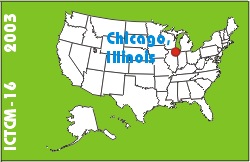
Electronic Proceedings of the Sixteenth Annual International Conference on Technology in Collegiate MathematicsChicago, Illinois, October 30-November 2, 2003Paper C018Modeling Geometric Objects Using Java |
Paul BouthellierDepartment of Mathematics and Computer Science University of Pittsburgh-Titusville Titusville, PA 16354 USA Phone: (814) 827-4432 Fax: (814) 827-5574 pbouthe@pitt.edu list of all papers by this author | Saeed DubasDepartment of Mathematics and Computer Science University of Pittsburgh-Titusville Titusville, PA 16354 USA Phone: (814) 827-5672 Fax: (814) 827-5574 dubas@pitt.edu list of all papers by this author |
| Click to access this paper: |
ABSTRACT
The Java programming language contains 2-dimensional graphical elements for lines, rectangles, ellipses, arcs, and polygons. Using these elements, along with fills, students in college algebra and beyond can model a wide variety of objects. Using Java for projects works quite well as constructing Java applications and applets is simple for students to understand-even if they have no prior knowledge of the language. An added bonus is that students can place their work on the web.As an introductory project, students in a course such as college algebra can be asked to model an object such as a no-smoking sign. This is the first example we will illustrate. The students are required to break the sign into simpler geometric shapes and derive their equations. The Java application and applet are then created.
More sophisticated modeling projects, such as cars and motorcycles, teach students about modeling more complex curves with polygons. This offers an excellent lead-in to teaching curve fitting by interpolating polynomials-which students will study in more advanced classes. A motorcycle will be modeled as our second example.
Often the best modeling projects will be suggested by the students themselves. Examples of past projects are: a detailed globe, a concept car, and a company logo. Students enjoy seeing their work placed on a web site and generally want to work on even more complex projects. Such interest often encourages students into furthering their mathematical studies.
